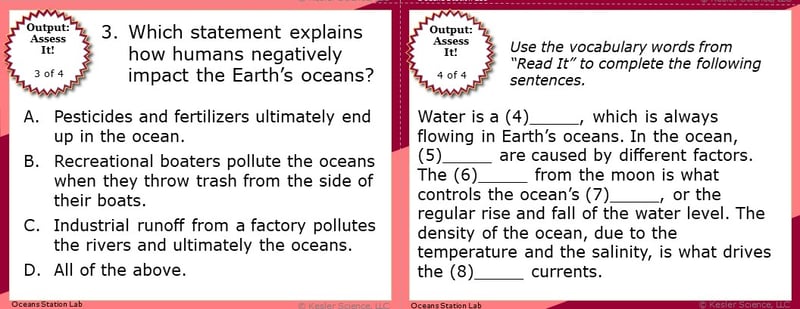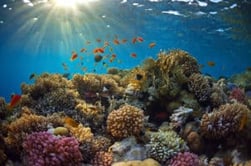Oceans Lesson Plan – A Complete Science Lesson Using the 5E Method of Instruction
By the end of this lesson about our oceans, students will be able to identify the elements that make up the ocean, associate salinity and temperature with density, recognize that the Sun provides the energy that drives convection within the oceans, produces surface and deep ocean currents, give examples of seafloor structures, including locations, recognize human dependence on ocean systems and explain how human activities have modified the oceans. Each of our lessons is designed using the 5E method of instruction to ensure maximum comprehension by the students. This well-thought out unit does the heavy lifting, giving teachers easy-to-implement, highly engaging lesson plans.
This blog will walk you through each of the steps and activities from the Oceans 5E Lesson Plan.
ENGAGEMENT
Objective Introduction
At the beginning of the lesson, the class will do a Think-Pair-Share to discuss the objective.
Class Activity
- Have the students make a circle around the classroom.
- Have one student toss the blow-up globe to another student.
- Have that student count how many fingers are touching the ocean.
- Someone record that number.
- Have the student with the globe toss it to another student, who again counts how many fingers are touching an ocean. Record the answer.
- Continue for 10 tosses.
- Add up how many total times students’ fingers landed on an ocean.
Student Activity
- Ask the students to guess the objective of this exercise.
- Then have them “guess” the percent of earth that is covered by oceans, rivers, glaciers, and ice caps.
- The ocean covers more than 70 percent of the surface of our planet. It’s hard to imagine, but about 97 percent of the Earth’s water can be found in our oceans. Less than one percent is found in rivers, lakes, and aquifers, and about two percent is frozen in glaciers and ice caps.
- Give the students the blank map of the world that is provided with the lesson, and see how many of the 5 oceans they can label. You might want them to label continents too.
- Tell them the correct answers and that they will be studying oceans in their next unit. (Atlantic, Pacific, Indian, Arctic, Southern)

The teacher will help to clear any misconceptions about oceans. A major misconception is that students may not connect oceans and weather patterns.
Estimated Class Time for the Engagement: 20-30 minutes
EXPLORATION
This student-centered station lab is set up so students can begin to explore oceans. With nine stations in total, you can introduce the oceans to your middle school students in a variety of ways! Four of these stations are considered input stations where students will learn new information about oceans, and four of the stations are output stations where students will be demonstrating their mastery of the lesson's material. A bonus station offers challenges for your early finishers and independent learners. You can read more about how I set up the station labs here.
Watch It!
At this station, students will be watching a short video explaining how we can keep plastics out of our oceans. Students will then answer questions relating to the video and record their answers on their lab station sheet. How much plastic trash is estimated to enter our ocean each year? Other than plastics, what other forms of pollution enter our oceans? What obstacles must be overcome in order to agriculture waste to decline?
Read It!
This station will provide students with a one-page reading about ocean currents. Students will read about what causes ocean currents and what drives them to continue. There are four follow-up questions that the students will answer to demonstrate their comprehension of the reading material.
Explore It!
Students will be working in pairs to better understand the ocean and its currents. Students will be examining an ocean current map from the National Weather Service. From the map, students will make observations as they try to understand how currents work and what the colored arrows mean on the map. Students will record their observations on their lab sheet.
Research It!
The research station will allow students to label underwater structures in an ocean. Students will be instructed to complete a few tasks and record answers on their lab sheets.
Organize It!
The Organize It station allows your students to organize vocabulary words learned in the oceans lesson plan to their correct definitions.
Illustrate It!
Your visual students will love this station. Students will draw their own diagram of the ocean floor and label the structures correctly. Students are encouraged to include structures: Continental Slope, Ocean Trench, Hydro-thermal Vent, Seamounts…just to name a few.

Write It!
Students who can answer open-ended questions about the lab truly understand the concepts that are being taught. At this station, the students will be answering three task cards: Describe what seafloor structures you might encounter if you could walk underwater from the United States to Europe. Choose one factor that causes ocean currents and discuss it in detail. Discuss two ways humans negatively impact the Earth’s oceans.
Assess It!
The Assess It station is where students will go to prove mastery over the concepts they learned in the lab. The questions are set up in a standardized format with multiple choice answers. Some questions include: What structure on the continental crust is most similar to an ocean ridge? Which sequence of events is correct? Which statement explains how humans negatively impact the earth’s oceans? Which statement is correct about ocean currents?

Challenge It! - Bonus Station
Early finishers and advanced students will love the extension activities in this station. Four activity choices offer them ways to expand their learning through mini-games and mini-projects.
Estimated Class Time for the Exploration: One or two 45-minute class periods
EXPLANATION
The explanation activities will become much more engaging for your class once they’ve completed the exploration station lab. During the explanation piece of the lesson, the teacher will be clearing up any misconceptions their students may have about oceans with a variety of materials. These materials include on-level and modified versions of the interactive presentation (may be used individually or projected), anchor charts, and paper or digital interactive notebook activities. If you have students that need modified notes, the 5E lessons come equipped to help give every student access to the lesson.
Interactive notebook samples: Above-left is a digital INB activity slide; above-right is an example of the paper INB activities.
The students will also be interacting with their journals using INB templates for oceans. Each INB activity is designed to help students compartmentalize information for a greater understanding of the concept. The oceans INB templates allow students to focus their notes on diagramming the ocean currents and the seafloor structures.
Estimated Class Time for the Exploration: Two or three 45-minute class periods
ELABORATION
The elaboration section of the 5E method of instruction gives students choices that allow them to prove they’ve mastered the concepts behind the lesson. When students are given a choice, they’re much more enthusiastic and invested in the project than they are when their teachers choose their projects for them. There are a total of nine choices to demonstrate understanding of our oceans. A separate set of choices that offer more teacher support are also available for students that need them. Rubrics guide students to doing their best work and assist in grading.

Estimated Class Time for the Elaboration: Two or three 45-minute class periods (can also be used as an at-home project)
EVALUATION
The final piece of the 5E model is to evaluate your students' comprehension. Included in every 5E lesson is a homework assignment, assessment, and modified assessment. Research has shown that homework needs to be meaningful and applicable to real-world activities in order to be effective. When possible, I like to give open-ended assessments to truly gauge the student’s comprehension.
Estimated Class Time for the Elaboration: One 45-minute class period
DOWNLOAD THE FULL LESSON NOW
Download Over $100 in FREE Resources
For Middle School Science
Simply create a login below and gain immediate access to a selection of our Kesler Science product line worth $100 - for FREE. There's a full version of every product type! You'll also join tens of thousands of middle school science teachers who receive timely tips and strategies straight to their inbox.







